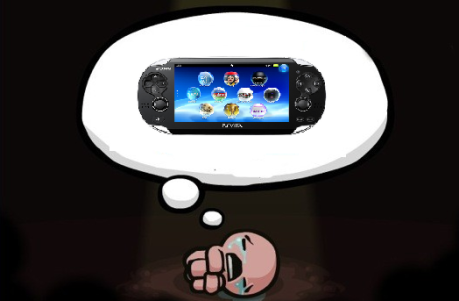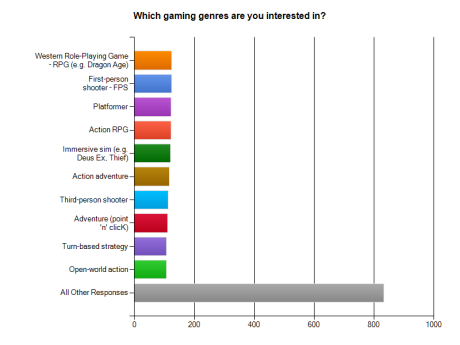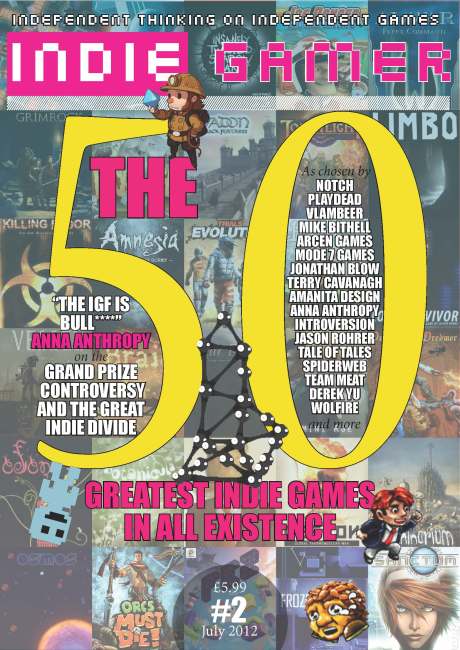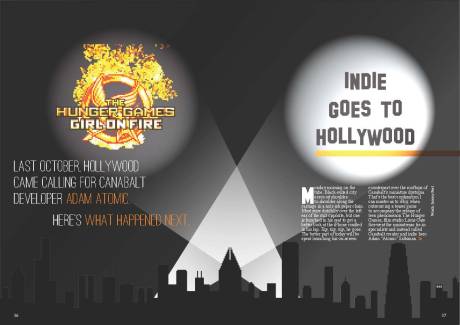That Bloody Hitman Trailer: A Sheep in Wolf’s Clothing
July 13, 2012
You got room in there for another opinion on everyone’s favourite topic of last month? Open a thought-valve and make some space for an explanation of why, like the slasher flick genre, it was as challenging as a pull-cap tin o’ beans.

A few weeks [pop culture months – Ed] ago, Kill Screen’s Michael Thomsen leapt to the defence of Hitman’s much-discussed pre-E3 trailer, noting that “it is possible to depict an act in art without endorsing it”:-
“While the women in the trailer are certainly meant to evoke sexuality, they are not necessarily meant to be arousing to the viewer… the point of the nun’s sexual depiction seems to me to be primarily a matter of contrast with the stark asexuality of 47.”
But already, we’ve given IO Interactive too much credit. Stuff the rest of it back in your pocket, and join me in counting this argument to bed.
Continue?
Five.
In art, depiction is not necessarily the bell that rings endorsement – true enough. Lets explore that possibility for a moment – that this universe is the one in which IO considered a pre-E3 trailer a fitting format for a subtext in which sexy nuns were but the vapour trail of a more ambitious message.
Perhaps, like a feminist lost among Duke Nukem 3D’s bosomed babes, Agent 47 is tearing down the archetypal imagery of objectification in the only way he is able – with a gun and a grimace. Or maybe, as Thomsen argues, the juxtaposition of pornographic cliché with our hitman’s cold killing serves to heighten his asexuality; as though a lesser professional might come over all howling wolf at the sight of the heels and latex and leave himself at a tactical disadvantage.
Four.
But if that’s so, why then in the trailer’s first minute does the camera return again and again to the busts and groins of its naughty nuns? If those shots are to lure us into objectification with the aim of showing us the error of our ways, where are those key reflections in the glass a la Silence of the Lambs, where director Demme shows us to be sharing a seat with the cannibal?
Instead, an explosive rocket-propelled climax gently buys us a familiar cocktail of sex and death. The heavens open, and frames of rain-slicked guns alternate with soaked latex until they become one and the same; 47 does his business, and leaves.
Three.
That’s because Hitman is employing the same thematic sleight of hand performed so regularly by the slasher flick: dressing hyper-conservative values in the gore-stained costume of ‘provocative’ art.
Like the gruesome punishment of the sexually active teen couple that has become a horror staple, the trailer makes a skin-deep stab at edginess, while reaffirming a patriarchal fantasy – that the chaste are really just dying for a good fuck.
Two.
We’re supposed to enjoy the titillation – What’s the line in Cabin in the Woods? “Let’s see some boobies. Got to keep the customers satisfied.” – before a violent reaffirmation of male superiority allows us to return to our lives satisfied that nothing has changed.
The action – crushed noses and all – might be shocking, even alienating, yet there is nothing challenging about it. Its surface level nastiness doesn’t signify a willingness to tackle the status quo, rather just that – nastiness, Hitman’s stock in trade.
One.
Can art be provocative? It certainly can. But if it’s provoking the vulnerable, it better have a bloody good reason for doing so. Hitman’s trailer challenges nothing, and as a result its upset serves no purpose at all.
None.
Indie gamers don’t own Vitas, and other gleanings
June 1, 2012
I recently dropped a survey about a potential indie games mag onto the marble tiles of the internet’s most public forum, Twitter. It broke under the scrutiny of hundreds – thanks to everybody who pointed out that Question 29 didn’t need an answer box, and that I’d erroneously credited Andy Schatz with Spy Party rather than Chris Hecker – but I let its contents trickle down the cracks, flowing at right angles through the interested segments of the internet.

The result is reams of stats about the playing and reading habits of a subculture of indie gamers, sourced from a relatively large sample (around 200) which has thrown up some intriguing points which I thought I owed it to you to share.
N.B. Whilst I’d like to think these results are representative of wider trends, respondents come mostly from a pool of my Twitter followers, their followers, and the most accommodating parts of the RPS forums. As such, any dramatic PC bias should be taken with a pinch of scepticism.
The first cause for brow arousal is the discovery of exactly who indie gamers are. It’s with the greatest condolences that I must inform you that 94% were men, with only 11 respondents admitting to being members of the fairer sex. Whilst anecdotally it seems to me that there are more female indie devs than there are women in key creative positions at major studios, it seems that some kind of indie jam affirmative action is in order.
86% fell within the broad spread of 18 to 35 years of age, with a clear majority in the 18-25 bracket. Shout out to the seven mid-teens who responded. I hypothesize, apropos of nothing but this, that indie games are something ‘discovered’ after years of intense interest in and/or frustration at the state of mainstream game design and pop culture; indie is not yet something leapt upon to defy the tastes of our parents, and we don’t yet have our NME.

The majority of indie gamers seem to be employed full-time, with 25% students and a further 9% unemployed, pretty much consistent with the UK national average. Not just hipsters after all, I can’t help but be happy to conclude. Indie gamers come from everywhere and do all sorts of things.
33% of respondents were employed in the games industry, with an astonishing 59% already self-employed as indie developers or aspiring to be so, a result likely skewed by the heavy concentration of indie devs on my Twitter feed. Nevertheless, it certainly proves that indie developers are immersed in the culture and the games of their peers; mainstream development reportedly leaves no time for videogames.
On and on, further up and further in, to the gaming platform question. I’m going to try and ignore the slightly dodgy PC stat (who doesn’t own a PC?) and tell you that all current generation home consoles were neck-and-neck, although notably the Wii owners slightly outnumbered the traditionally ‘core’ PS3 types. Adoption of both the 3DS and PS Vita has been extremely slow and cautious in what I’ll hesitantly call this demographic, with 11% and a tiny 6.5% indulging respectively. Neither have shown to be particularly fertile ground for indie development, and I wonder if this is an early sign that lack of support for small teams might be costing platform holders.

“But how do indie gamers buy?”, prompts Dubious Segue, my Mexican structure servant and stalwart friend. Well, they don’t buy into the event release cycle, that’s for sure. Only 1% claimed to always buy games on release, with a majority of 47% plumping for ‘Sometimes’, which seems an annoyingly vague option in retrospect.
More intriguing is the fact that more than half buy games released in alpha – that is, unfinished, usually with the promise of more features and eventual bug-quashing to come. Minecraft is surely almost entirely responsible for changing attitudes on this, and for paving the way to a world in which thousands will now gladly cough up for nascent projects in good faith that they will ultimately end up with something that plays like Their Kind of Game.
59% of indie gamers ‘usually’ buy games via digital distribution, thwarting with a flourish any lingering doubts about the worth of high street retail to indie devs. 98% have used Steam, with GOG.com following at a respectable 56%. Xbox Live Arcade sits at 42%, whilst Xbox Live Indie Games languishes at 26%; further proof if it was necessary that, even within its target market, few will brave Microsoft’s deserted clone shop (not to dismiss the significant but isolated successes of developers like Zeboyd Games).
In the gaming genre question, enthusiasm was particularly high for the declared dead, including point-and-click adventure games (67%), story-driven western RPGs (76%), turn-based strategy (65%) and the RTS (57%). One of the most popular was the immersive sim (73%), exponents of which include Deus Ex, System Shock 2 and the Thief series.

I’m reminded of Clint Hocking’s 2008 immersion talk (if anybody still has a working video link, I’d love to have it), in which he suggested that whilst (his) Generation X was reared on an insular, lonely definition of game immersion that it still clings to, for Gen Y immersion means interconnectedness with other people in-game people through our various devices and social platforms. Yet, for indie gamers at least, the immersive sim is still on top whilst social games (4.2%) remain virtually untouched.
That’s all for now, though there’s another similarly-sized piece to be written on reading habits and games media consumption, if interest is sufficient. Discussion in the comments section would be lovely to see.
Indie Gamer is a dedicated UK indie games magazine
May 30, 2012
Thought I’d better let you in on what I’ve been working on for the past few week-bundles. So come on in, but close that door; you’re letting all the ideas out.
Indie Gamer [is/will be/ought to be] a consumer special interest magazine published in the UK. It’s a dedicated indie games mag, designed from the ground up to be about people, not companies.
Criticism very much appreciated, in addition to your funding and/or the backing of your publisher.
More to follow in the coming days, in the form of analysis of that survey wot I did.
[Click images for full size]
Doves
October 19, 2011
This originally written for a feature – about weird moments in otherwise normal games – that we put together over at BeefJack recently, but it didn’t quite fit. I’ve let it make its nest here though, where it can be a nasty little square peg and shout about it.
GTA London was Rockstar North’s one and only crack – a vicious, sickening, audible snap – at an openly real-world setting. It was the 60s London of the movies, replete with cabbies, Caine-alikes and a suitably vibrant soundtrack unmatched in its evocation of time and place, at least until the release of Vice City.
Beyond that, it was horrible. Beneath the inviting, nostalgic half-reality surface of its sandpit, Rockstar buried nails and matches. Long before anyone thought to combine hookers with baseball bats, GTA London’s emergent playground could render the meeting of Buckingham Palace and rocket launchers in colourful 2D. It didn’t so much court controversy as jump in its underwear and then hawk its conquest all round town. Worse though, it had doves.

No more than twelve pixels long and completely static, London’s doves bask on the pavements and cluster around benches, puckering in the fumes and the vehicular heat. Until they’re run over, with cruel inevitability, at which point their bloody corpses literally roll across the screen in acts of post-mortem passive aggression.
It is, one can only assume, a guilt-powered defence mechanism for the greater good of the race, a peaceful protest designed to incrementally depress you into playing nice as dead birds begin to litter the streets. After all, as any career criminal will tell you, the hardest kill is that which silently gets stuck under your wheels as you careen about town in a bright red double-decker bus.

If nothing else, their strange sacrifice serves to warn GTA London’s human residents of the coming storm. The tin cans tied to the cars of newlyweds signal their joy to those in their wake. The distant sound of reggaeton, accompanied by the syncopated thud of bloodied doves against the bumper of a black cab, spells direst foreboding to the pedestrians of Hyde Park.
As I wipe bits of bird from my windscreen, I sigh and wonder what Charlie Croker would have done in my loafers. “Another feather in my bonnet,” he’d say, cool as a Cooper. But then he never had to put up with this…
The Perfect Game
April 8, 2011
A small number of weeks ago, the delectable Sheffield student paper Forge Press put together a feature on The Perfect Game, in which myself and several other chin-strokers pitched their ideal isometric find-the-object-in-space sims and the like. Only went and undermined the whole affair, like a bastard. You’ll see.
What kind of unambitious, slick-haired, dead-eyed necro-human wants a perfect game? I mean, sure, I’ve played a few. They were okay. Read the rest of this entry »
Indie-cent Exposure #6: A-QWOP-bop-a-loo-bop…
December 5, 2010
…a-lop-bop-bop TUTTI FRUTTI! I can only speculate as to how Little Richard would have changed the hook to his signature tune had he been born in 1990 and read about horrible running sim QWOP in the sixth instalment of Indie-cent Exposure in the last days of 2010. I am sure, however, that these would have been the first two paragraphs of the post he read, appearing as they do, at the beginning:-
I’m not very good at running. I’m one of those weird, lengthy, limb-flailing types, lethal over short distances but a danger only to myself once the lactic acid kicks in. Reason being, I don’t do it much day-to-day as I’m not often chased, and I’m not one of those people who can run to keep fit and find it satisfying enough to make the necessary sweaty slog feel worthwhile.
As far as I’m concerned, there’s no depth to running’s appeal; there’s technique to master, I guess, but not to any particular end, like there is in badminton or foot-to-ball. There’s no system to properly engage with, not enough elements at play to create interesting or fun situations. Not enough game, in short, to distract me from the fact I’m getting fit and my calves are melting. Read the rest of this entry »
Indie-cent Exposure #5: Missing Gish
November 25, 2010
My indie gaming column emerges this week looking wistful and sighing a lot as I take a backwards look at 2005’s side-scrolling physics-’em-up, Gish. Here’s the first bit:-
Hello,
We’re going to talk about Super Meat Boy. Could be you don’t already know about Meat Boy, but hush – you’re going to play along, so that tomorrow when your semi-savvy Xbox-owning friend tries to tell you about it, you can grimace and roll your eyes.
“Christ, Xbox, you’re so patronising,” you’ll say, knowing how much he hates to be referred to by his favoured console. “Do you think I know nothing of the indie smash hit of the year? Super Meat Boy turns precision through repetition into an art form, chipping an amalgam of the best platformers down to its pure genius core before coating the result in a gloopy mess of blood, guts and blood. Now justify your existence and make me a cup of tea, will you?” Read the rest of this entry »
Minecraft: Living It
November 20, 2010
Forge Press did a gorgeous feature on the world’s easiest sheep-shearing sim a few weeks ago, and I wrote a pretentious NGJ piece for it. Some time passed, and I posted it on Rock Paper Shotgun’s Writer Hive.
Deep underground, I creep towards the edge of the precipice. Closer to the surface I had planted burning torches in the sediment to illuminate my way down, but now the white glow of the magma provides me with all the light I need to get to work.
Scanning the cavern roof, I spy a blue-grey gleam in the false twilight. Diamond. With one eye on a nearby subterranean river, I scan the contents of my bag like a golfer preparing for a shot, eventually selecting an iron pickaxe.
It’s only short; stick the kettle on, click this link and you’ll be done with it before you can say WHERE IN THE BLUE HELL ARE MY HOBNOBS.
Indie-cent Exposure #4: Not Indie-cent Exposure #4
November 14, 2010
If you’re an aspiring indie developer, a regular reader of this column or a human being who values their continued existence, you’d damn well better read this:-
Welcome, friends.
It is my task to inform you that this week’s edition of Indie-cent Exposure, a whimsical and highly fictionalised look at the state of independent gaming in the 21st Century, has been postponed until further notice.
This is for your own protection.
Four weeks into our shared journey through the world of indie games, it has occurred to me that some of you may already have picked up your tools and set up shop as independent developers. As such I feel duty-bound to prepare you for action in the event that your gentleman’s honour is threatened by a fellow game-maker. Read the rest of this entry »
Indie-cent Exposure #3: Super Deconstructive Box
November 9, 2010
Hello? Hello! This week I wrote about the marvellous Super Crate Box, the mind-bouncing ROM Check Fail and the deconstructive use of indie games.
I know it’s been a little while so I’ll ease you into it. C’mon, we’ll sing the first part together:
What does the term ‘Super Crate Box’ mean to you, reader? Maybe it’s a setting in Team 17’s new Worms Apocalypse 4 3D Arcade 2D Edition. It might be your affectionate, Neanderthal way of referring to your GameCube. Could be. Or perhaps your thoughts turn to that delicious hamper of sweet fruit and crisp breads that your dear mother sends you each Christmas. Mmm. Read the rest of this entry »




